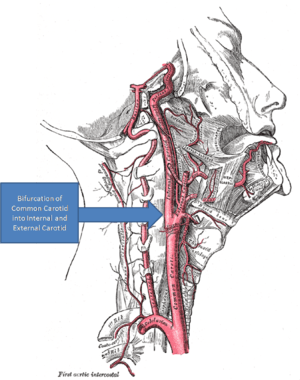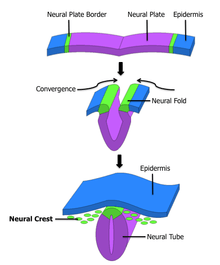Glomus cell
Glomus cells are the cell type mainly located in the carotid bodies and aortic bodies. Glomus type I cells are peripheral chemoreceptors which sense the oxygen, carbon dioxide and pH levels of the blood. When there is a decrease in the blood's pH, a decrease in oxygen (pO2), or an increase in carbon dioxide (pCO2), the carotid bodies and the aortic bodies signal the dorsal respiratory group in the medulla oblongata to increase the volume and rate of breathing.[1] The glomus cells have a high metabolic rate and good blood perfusion and thus are sensitive to changes in arterial blood gas tension. Glomus type II cells are sustentacular cells having a similar supportive function to glial cells.[2][3][4]

Structure
The signalling within the chemoreceptors is thought to be mediated by the release of neurotransmitters by the glomus cells, including dopamine, noradrenaline, acetylcholine, substance P, vasoactive intestinal peptide and enkephalins.[5] Vasopressin has been found to inhibit the response of glomus cells to hypoxia, presumably because the usual response to hypoxia is vasodilation, which in case of hypovolemia should be avoided.[6] Furthermore, glomus cells are highly responsive to angiotensin II through AT1 receptors, providing information about the body's fluid and electrolyte status.[7]
Function
Glomus type I cells are chemoreceptors which monitor arterial blood for the partial pressure of oxygen (pO2), partial pressure of carbon dioxide (pCO2) and pH.
Glomus type I cells are secretory sensory neurons that release neurotransmitters in response to hypoxemia (low pO2), hypercapnia (high pCO2) or acidosis (low pH). Signals are transmitted to the afferent nerve fibers of the sinus nerve and may include dopamine, acetylcholine, and adenosine.[8] This information is sent to the respiratory center and helps the brain to regulate breathing.
Innervation
The glomus type I cells of the carotid body are innervated by the sensory neurons found in the inferior ganglion of the glossopharyngeal nerve.[9] The carotid sinus nerve is the branch of the glossopharyngeal nerve which innervates them. Alternatively, the glomus type I cells of the aortic body are innervated by sensory neurons found in the inferior ganglion of the vagus nerve. Centrally the axons of neurons which innervate glomus type I cells synapse in the caudal portion of the solitary nucleus in the medulla. Glomus type II cells are not innervated.
Development

Glomus type I cells are embryonically derived from the neural crest.[2] In the carotid body the respiratory chemoreceptors need a period of time postnatally in order to reach functional maturity.[10] This maturation period is known as resetting.[11] At birth the chemorecptors express a low sensitivity for lack of oxygen but this increases over the first few days or weeks of life. The mechanisms underlying the postnatal maturity of chemotransduction are obscure.[8]
Clinical significance
Clusters of glomus cells, of which the carotid bodies and aortic bodies are the most important, are called non-chromaffin or parasympathetic paraganglia. They are also present along the vagus nerve, in the inner ears, in the lungs, and at other sites. Neoplasms of glomus cells are known as paraganglioma, among other names, they are generally non-malignant.[12]
Research
The autotransplantation of glomus cells of the carotid body into the striatum – a nucleus in the forebrain, has been investigated as a cell-based therapy for people with Parkinson's disease.[13]
References
- Lahiri S, Semenza G, Prabhakar NR, eds. (2003). Oxygen sensing : responses and adaptation to Hypoxia. New York: Dekker. pp. 200, 232. ISBN 978-0824709600.
- Pearse AG, Polak JM, Rost FW, Fontaine J, Le Lièvre C, Le Douarin N (1973). "Demonstration of the neural crest origin of type I (APUD) cells in the avian carotid body, using a cytochemical marker system". Histochemie. 34 (3): 191–203. doi:10.1007/bf00303435. PMID 4693636.
- Lawson, W (January 1980). "The neuroendocrine nature of the glomus cells: an experimental, ultrastructural, and histochemical tissue culture study". The Laryngoscope. 90 (1): 120–44. doi:10.1288/00005537-198001000-00014. PMID 6243386.
- Eyzaguirre, C; Fidone, SJ (November 1980). "Transduction mechanisms in carotid body: glomus cells, putative neurotransmitters, and nerve endings". The American Journal of Physiology. 239 (5): C135-52. doi:10.1152/ajpcell.1980.239.5.C135. PMID 6108075.
- Pardal, R.; Ludewig, U.; Garcia-Hirschfeld, J.; Lopez-Barneo, J. (11 February 2000). "Secretory responses of intact glomus cells in thin slices of rat carotid body to hypoxia and tetraethylammonium" (PDF). Proceedings of the National Academy of Sciences. 97 (5): 2361–2366. Bibcode:2000PNAS...97.2361P. doi:10.1073/pnas.030522297. PMC 15806. PMID 10681419.
- Wang, ZZ; He, L; Stensaas, LJ; Dinger, BG; Fidone, SJ (February 1991). "Localization and in vitro actions of atrial natriuretic peptide in the cat carotid body". Journal of Applied Physiology. 70 (2): 942–6. doi:10.1152/jappl.1991.70.2.942. PMID 1827111.
- Allen, A. M. (1 August 1998). "Angiotensin AT1 receptor-mediated excitation of rat carotid body chemoreceptor afferent activity". The Journal of Physiology. 510 (3): 773–781. doi:10.1111/j.1469-7793.1998.773bj.x. PMC 2231066. PMID 9660892.
- Carroll, JL; Kim, I (15 November 2005). "Postnatal development of carotid body glomus cell O2 sensitivity". Respiratory Physiology & Neurobiology. 149 (1–3): 201–15. doi:10.1016/j.resp.2005.04.009. PMID 15886071.
- Gonzalez, Constancio; Conde, Silvia V.; Gallego-Martín, Teresa; Olea, Elena; Gonzalez-Obeso, Elvira; Ramirez, Maria; Yubero, Sara; Agapito, Maria T.; Gomez-Niñno, Angela; Obeso, Ana; Rigual, Ricardo (2014). "Fernando de Castro and the discovery of the arterial chemoreceptors". Frontiers in Neuroanatomy. 8: 25. doi:10.3389/fnana.2014.00025. ISSN 1662-5129. PMC 4026738. PMID 24860435.
- Hempleman, SC; Pilarski, JQ (31 August 2011). "Prenatal development of respiratory chemoreceptors in endothermic vertebrates". Respiratory Physiology & Neurobiology. 178 (1): 156–62. doi:10.1016/j.resp.2011.04.027. PMC 3146631. PMID 21569865.
- Carroll, JL; Kim, I (1 January 2013). "Carotid chemoreceptor "resetting" revisited". Respiratory Physiology & Neurobiology. 185 (1): 30–43. doi:10.1016/j.resp.2012.09.002. PMC 3587794. PMID 22982216.
- Anne Marie McNicol (2010). "Chapter 12: Adrenal medulla and paraganglia". Endocrine Pathology: Differential Diagnosis and Molecular Advance (Springer ed.). p. 281.
- Mínguez-Castellanos, Adolfo; Escamilla-Sevilla, Francisco; Hotton, Gary R.; Toledo-Aral, Juan J.; Ortega-Moreno, Angel; Méndez-Ferrer, Simón; Martín-Linares, José M.; Katati, Majed J.; Mir, Pablo (August 2007). "Carotid body autotransplantation in Parkinson disease: a clinical and positron emission tomography study". Journal of Neurology, Neurosurgery, and Psychiatry. 78 (8): 825–831. doi:10.1136/jnnp.2006.106021. ISSN 1468-330X. PMC 2117739. PMID 17220289.